Football Field LED Lighting Guide & Solution
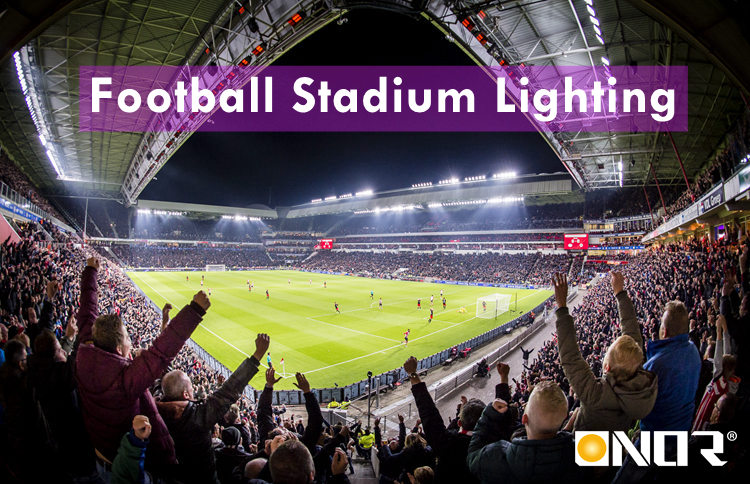
Are you thinking of replacing the traditional with LED lighting? Football is a popular sport that is played all over the world. There was a time when football was played outdoors only. In recent times, it is a sport that is played all day, both outdoors and indoors.
When it comes to lighting, it has a huge role to play, especially for indoor stadiums. A good LED lighting will keep everyone safe by illuminating the stadium properly. This has a direct impact on the performance of the players as well. It helps in increasing the vision of players and spectators. If the light is harsh for them, it will prevent them from performing well.
Since every sport has different requirements, no one type of lighting design can suit every stadium. This is the reason you need to focus on the lighting requirement when buying LED lighting. There are different types of LED lighting, making it a challenging and dreadful task to buy the right LED light for football stadiums.
In this post, we have made a comprehensive guide for football field LED lighting. Have a look!
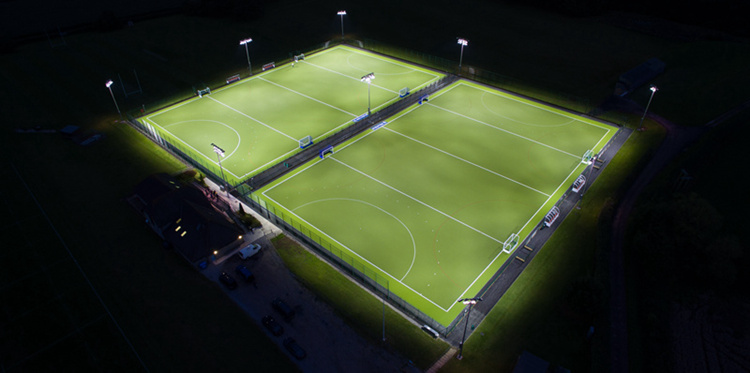
What is Football Field Lighting?
The lights used in a football field are high-power lights, having enough power to illuminate the whole stadium. Good lighting will distribute the light across the football stadium well. Usually, the football stadium has lights on both sides.
No matter how big or small the stadium is, the right type of lighting is essential. A well-lit stadium will improve the vision of both, spectators, and players. The ball must be easily visible to everyone.
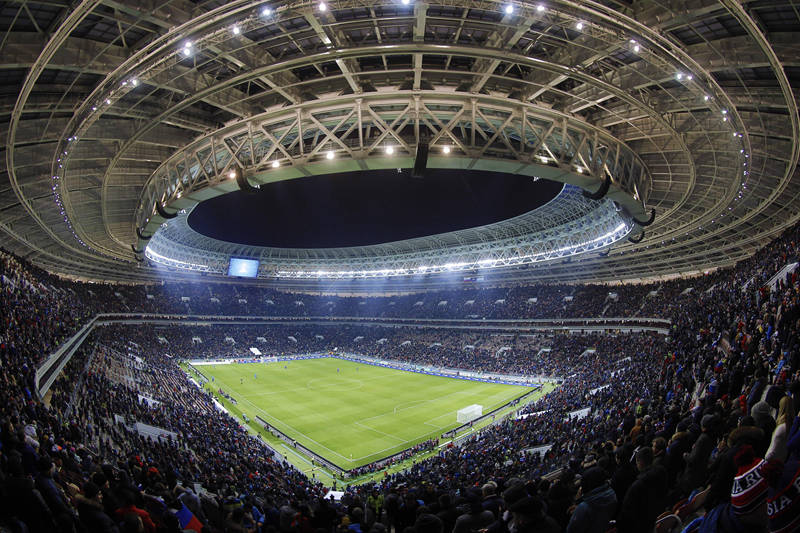
Lighting Requirements for Football Field
Before changing your traditional lighting for football stadiums, there are numerous things to focus on.
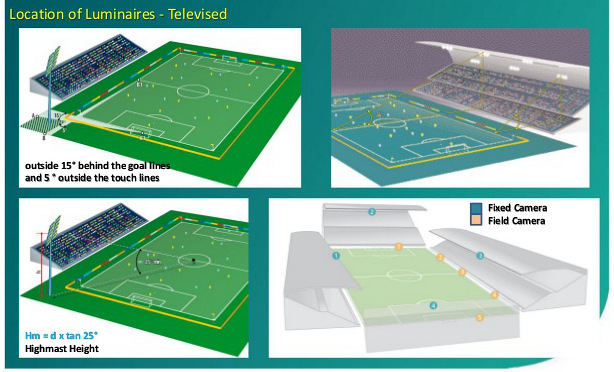
1. Power of LED Lights
The first requirement you should focus on is the power of LED light you will need. In order to have a better understanding of the power required, take a look at this example. The size of the football field is 105 x 68 m. The total area of the field might require 2,000 lux. This means total lumens required are 7,140 x 2000 = 14,280,000. The average luminous efficiency of the LED light is 140 lm/W. The minimum wattage required is 14,280,000/ 140 = 102,000 watts.
2. Brightness Level
One of the most important factors to consider is the brightness level. The lighting of the football field requires vertical and horizontal luminance. The vertical luminance is useful for the portrait of the players. On the other hand, horizontal luminance will cover the football field.
It is recommended that the football stadium should have 1500 lux for a vertical while 2000 lux for horizontal.
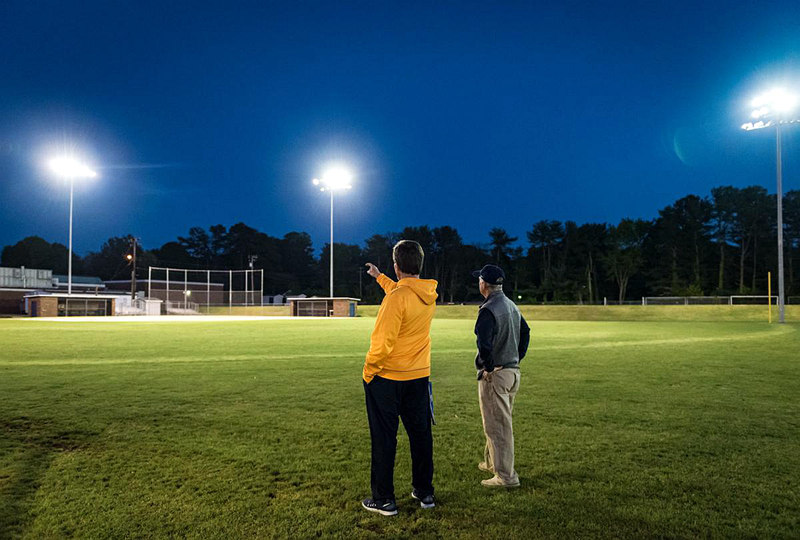
3. Compatibility of TV Broadcasting
We are living in a digital age where 4K TV broadcasting is the norm. For allowing high-quality video and photo production, the LED light must offer good vertical and uniform luminance. It also requires you to put in efforts to reduce the glare of the lights. This is the reason why LED lights are an excellent choice.
Most LED lights have anti-glare optics that will eliminate the dazzling and flickering feeling. By using special lens cover and coating, the brightness level can be maintained at the same time, unwanted glare is reduced.
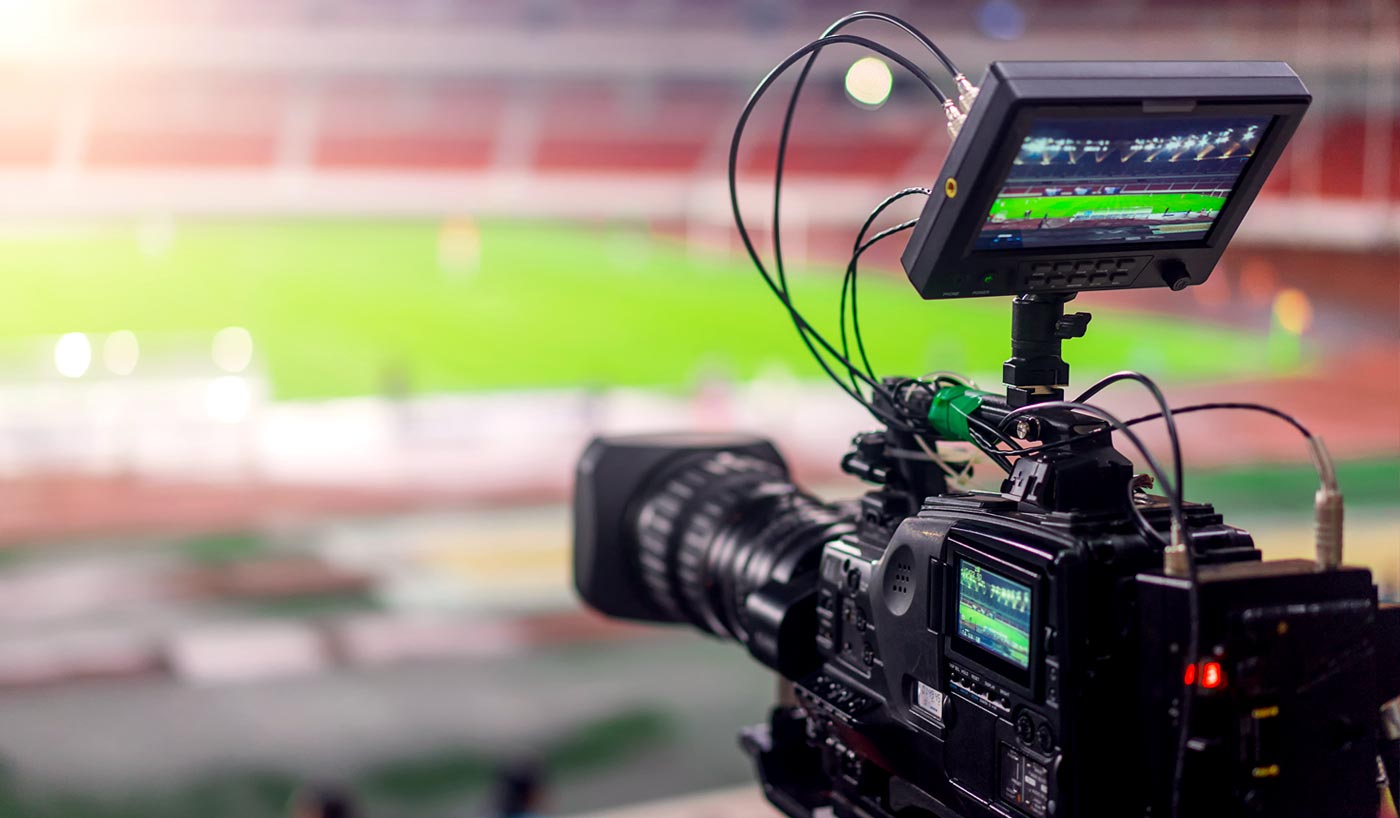
4. Uniformity of Light
According to the authorities of UEFA, the football field lighting should have uniformity between 0.5 to 0.7. The uniform distribution of light is measured through a scale ranging from 0 to 1. This factor has a critical role to play in deciding the lighting of a football stadium. It is because uneven lighting will adversely affect the eyes of spectators and players.
When it comes to achieving uniformity, it is not as easy as it seems. Since the light spot is rectangular or circular, there will be overlapping in certain areas and some areas will not have overlap. To provide uniform LED light, it must have less power and a smaller beam angle. You can even use the asymmetric design that will enhance the lighting distribution.
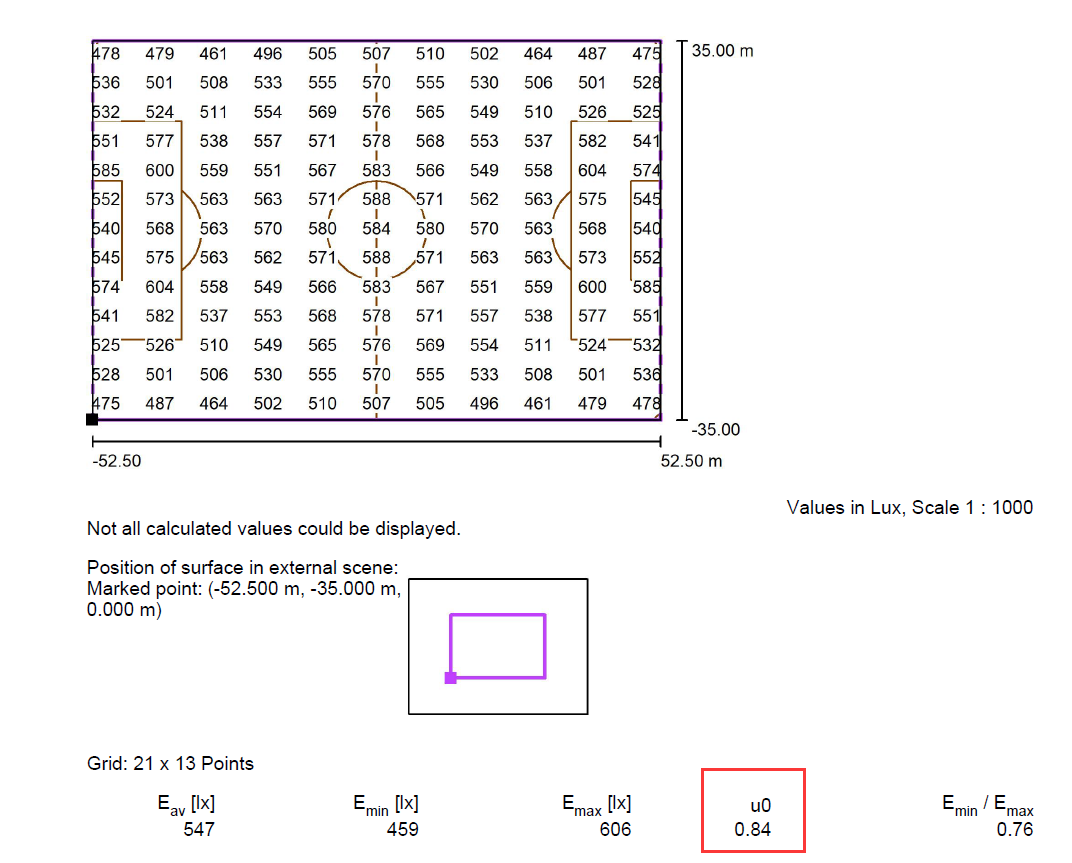
5. Pollution Problem
Good lighting for the football field should not lead to light pollution. This is because light leakage has a direct impact on the neighboring areas. The ground brightness of the stadium should be between 25 to 30 lux.
At Onor Lighting, you can find all types of LED lights including lights for the Olympic Games and Premier League.
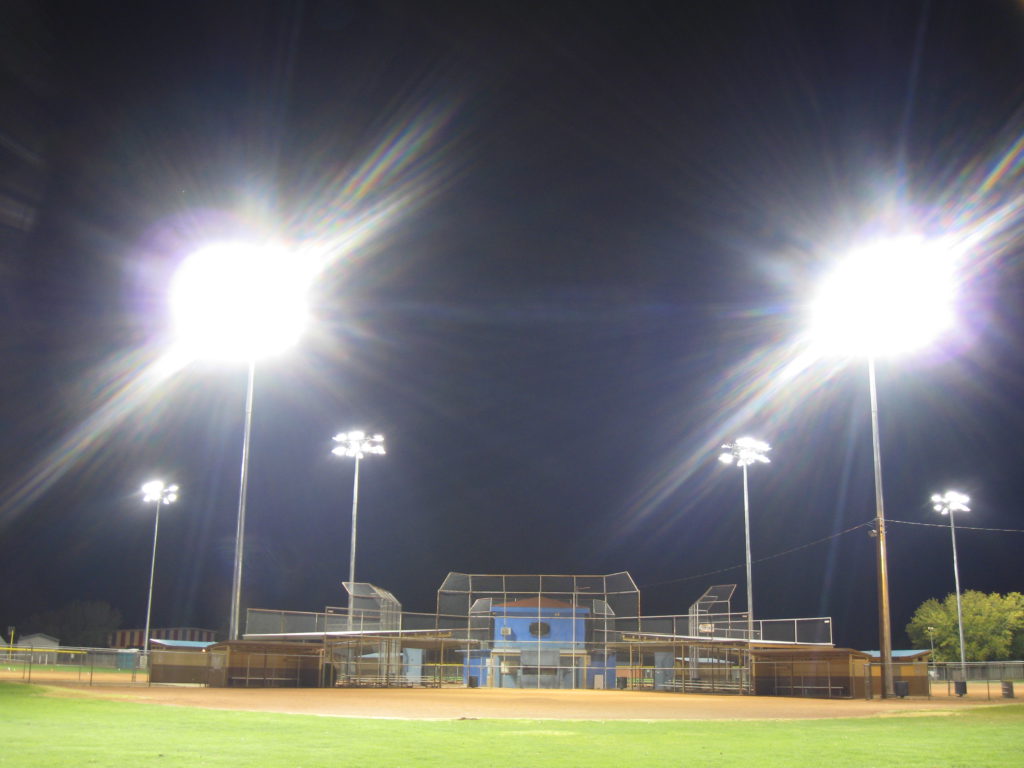
6. Height of the Roof
Another requirement for stadium light is the height of the stadium roof. The height must range from 30 to 50 meters. In order to have the best lighting, the loss of luminance must be minimal. An important thing to keep in mind is that loss of light is inevitable. 100% of the light beam is not projected on the football field. Nearly, 30% is scattered to the surrounding areas.
To resolve this problem, there are two easy ways. You can use better optics and increase more lighting fixtures. For example, you are required to have 10,000 watts to light up the stadium. This means you will need to have 12,000 to 13,000 watts to have the best outcome.
7. Lifespan
The lifespan of the lighting should be long as the light will be turned on at least 8 hours a day. LED lights are a better option because they have an average span of 80,000 hours. Moreover, they can last for 25 years with less to zero maintenance.
Onor Lighting provides the perfect lighting solution for all types of the stadium. All the LED lights are of top-quality that are long-lasting.
Factors to Consider When Designing Lighting for Football Field
Without a doubt, good lighting is crucial for unleashing the full potential of the stadium lights. You cannot just randomly place light poles across the field. there are some factors that you need to consider. Here are some of the most important factors.
1. Size of Football Stadium
For having accurate stadium lighting, you need to have the layout of the stadium and poles. This is the reason why a 3D model of the stadium is created. You have to keep in mind the more information you have, the more precise the lighting plan will be.
Mostly, the stadium has nearly 6-pole, 4-pole, or round roof lighting arrangements. Commonly, the height of the mast pole varies from 30 to 50 meters. When it comes to installing, the size of the stadium has an important role. The lights are installed in the stadium corresponding to 3D light poles.

2. Choosing the Right LED Stadium Lights
For lighting up a stadium for Premier League, UFEA, or any professional games, you will need plenty of high-power LED lights. Using the same setting or layout is not recommended for different projects. This is because the horizontal distance between pole and field, lux requirement, and pole height are different. It is the reason why every stadium has varying lighting settings.
The Onor Lighting is a great LED light expert who will help you choose the suitable beam angle combination and power of LED lights.
3. Testing the Lighting
For improving the uniformity of light, the lights will be rotated using the software. The projection angle of every light is adjusted for optimizing the uniformity and brightness.
4. Photometric Report
Once the adjustment is completed, a photometric report is generated with excellent available luminaires and optics. This DIALux file contains isolines, false color rendering, and value charts. It helps in offering even and precise lighting for the stadium.

How to Choose the Best LED Light for Football Stadium?
There are numerous factors to consider when picking the right LED light. Take a look at some of the most important factors.
1. Luminous Efficacy
One of the first things you should pay attention to is the luminous efficacy. LED lights are quality and durable lights that will reduce the maintenance cost. They are capable of using less quantity and low power of light.
2. Ani-glare Feature
Not many people focus on this feature. Glare causes discomfort both, players, and audience. This compromises the vision and playing abilities of the player. In order to see everything clearly, you have to get an LED light with an anti-glare lens.
3. Color Temperature
Another thing you should consider is color temperature. The general color temperature required for the football stadium is 4000K. However, mostly 5000K to 6000K color temperature for delivering better brightness and illumination.
4. Water Resistance Properties
The LED light must be waterproof and have an IP65 rating. This is because you will be able to use the light anywhere you like, outdoors and indoors.
5. Heat Dissipation
The LED lights are a better option for football field lighting because they will not trap the heat inside. If the heat is retained, the life span might be affected and will increase the risk of accidents.
In the end, football field lighting is an essential aspect that must be carefully planned. We hope this guide will help you choose an ideal LED light. If you still have a problem, Onor Lighting is here to help you. We have a team of experienced and talented professionals who will put in their best efforts to help you design the lighting properly.
Lighting Standard
The lighting standard refers to the national standard JGJ153-2016, and the lighting requirements for the football field are as follows:
Outdoor Football Field
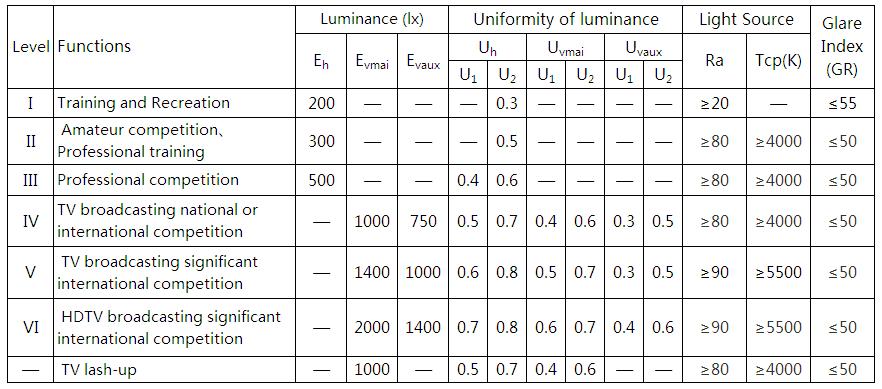
Outdoor Football Field
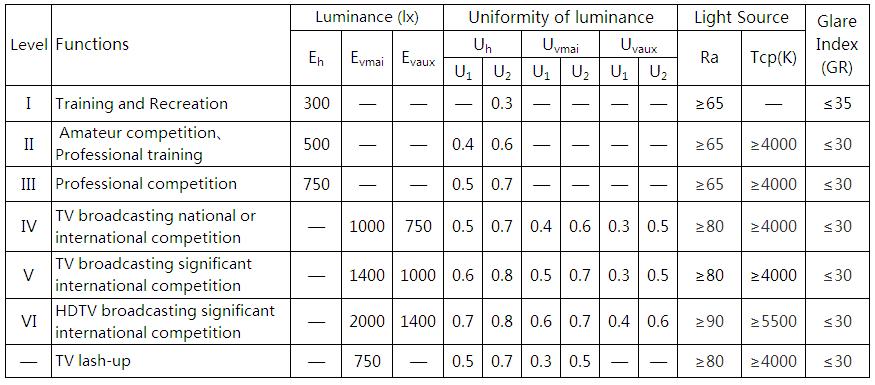
Arrangements of Lights
Lighting quality of football field mainly depends on average illumination and illumination uniformity of football field as well as glare control of lamps. Football lighting should not only meet the illumination requirements of players, but also meet the needs of spectators.
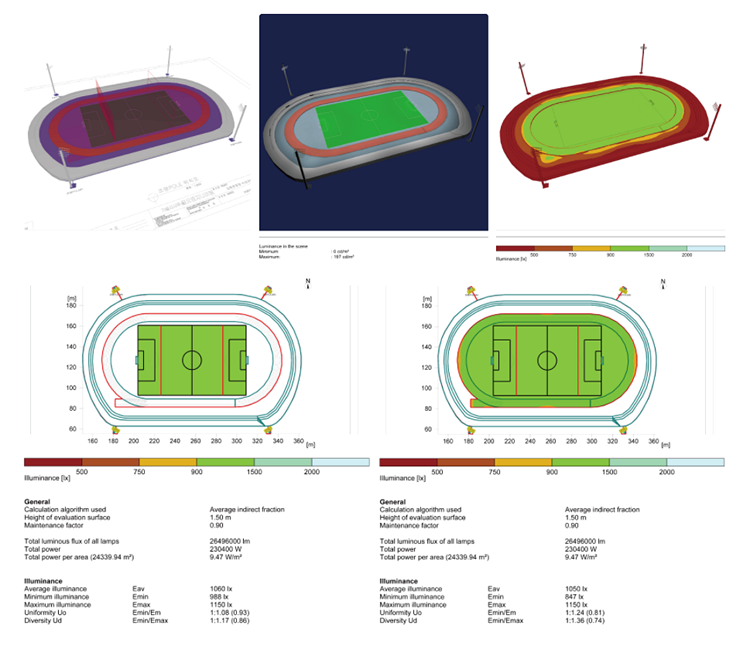
Outdoor football field
1. Common lighting methods without TV relay requirements are as follows:
a. Four corners layout
When the four corners of the field are arranged, the angle between the line from the bottom of the light pole to the midpoint of the sideline of the field and the sideline of the field should not be less than 5°, and the angle between the line from the bottom of the light pole to the midpoint of the bottom line and the bottom line should not be less than 10°, the height of the lamp should satisfy that the angle between the line from the center of the light shoot to the center of the venue and the plane of the venue should not be less than 25°.
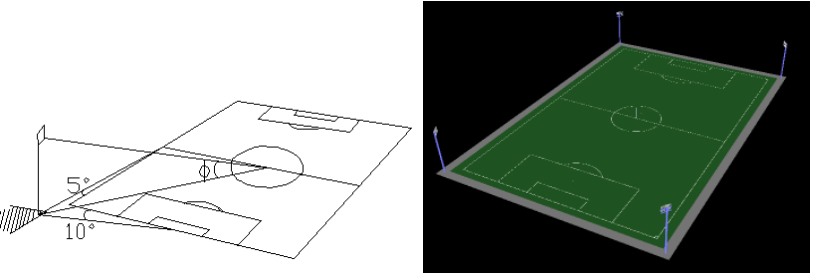
b. Side arrangement
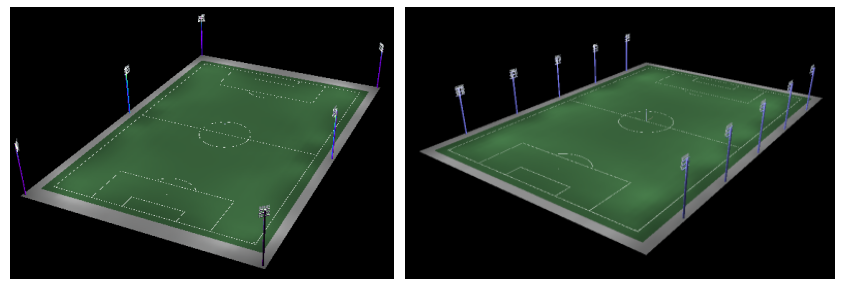
When decorating both sides of the field, the lamps should not be arranged within 10 ranges of the center point of the goal along the bottom line, the distance between the bottom of the lamp pole and the side line of the field should not be less than 5 meters, and the height of the lamps should meet the included Angle between the vertical line between the lamps and the center line of the field and the plane of the field should not be less than 25 as shown in the figure below:
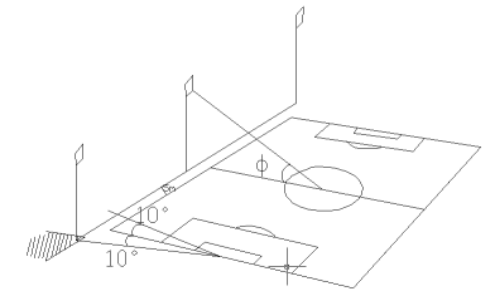
c. Horse track layout
For large-scale comprehensive stadiums, combining lighting design requirements and stadium building plans, it is advisable to set up horse tracks as needed. The number, height, direction and location of the horse tracks should meet the relevant requirements of lighting design and sports craftsmanship. Reasonable layout and number of horse lanes can not only realize the location and projection angle of lamps required by the lighting design, so as to minimize the number of lighting lamps installed, but also can be closely integrated with the architectural shape to highlight the architectural style of the stadium.
2. For football stadiums with TV broadcast requirements, the lighting method mainly has the following points for attention:
a. When using the layout on both sides of the venue
When the lights are arranged on both sides, the lights should not be arranged within 15° of the center point of the goal along the bottom line.
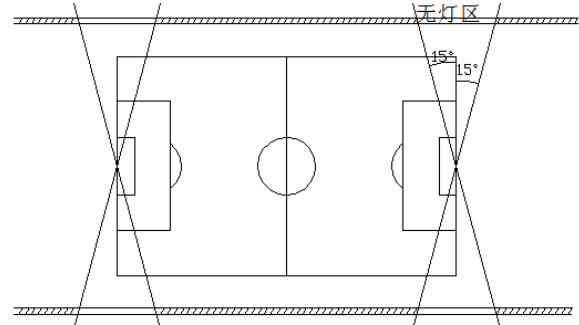
b. When the four corners of the site are arranged
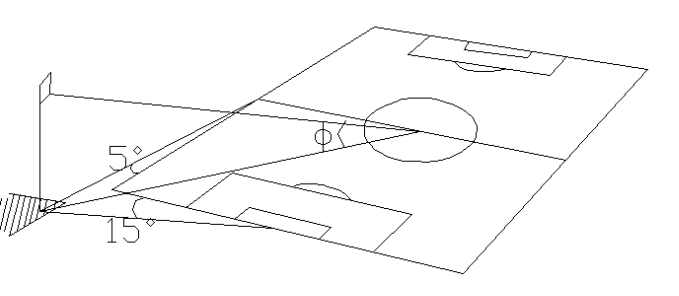
c. When mixed layout is adopted, the position and height of the lamps shall meet the requirements of Both sides layout and four-corner layout
d. In any other case, the arrangement of the light poles shall not obstruct the view of the audience
Indoor football field
Indoor football courts are generally used for training and entertainment. Indoor basketball courts can use the following lighting methods:
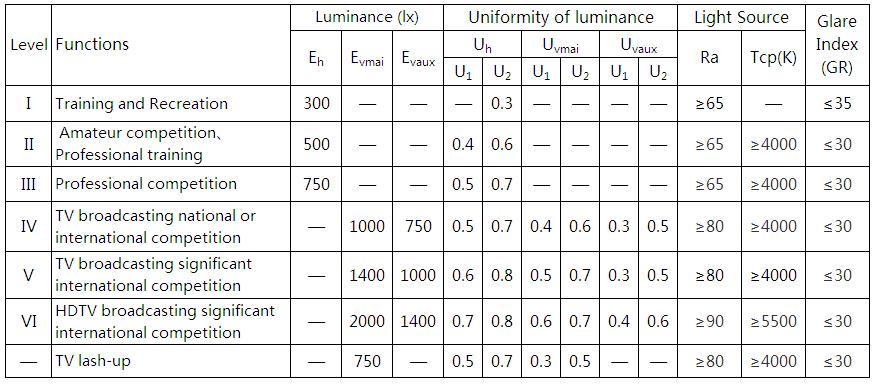
1. Top layout
It is only suitable for low-demand scenes. The top luminaire will cause glare for athletes. For high-demand ones, it is better to use both sides.
2. Side wall installation
The side wall should be installed with floodlights, which can provide better vertical illuminance, but the projection angle of the lamps should not be greater than 65°.
3. Mixed installation
The lamps are arranged in a combination of top installation and side wall installation.
LED Football Floodlights Selection
The selection of outdoor football field lamps needs to consider the installation position, the beam angle of the lamps, and the wind resistance coefficient of the lamps. Huitianxia LED flood light, the light source adopts the original imported brand, and the beautiful and generous shape will make the whole sports field look more high-end. The new energy lamps of Huapu are comparable to the special lamps of the national football team training venue. After professional optical design, The light beam is accurate, which greatly improves the utilization of the lamps. The lights are installed around the venue without glare and glare, so that the athletes can play a better level in the game.
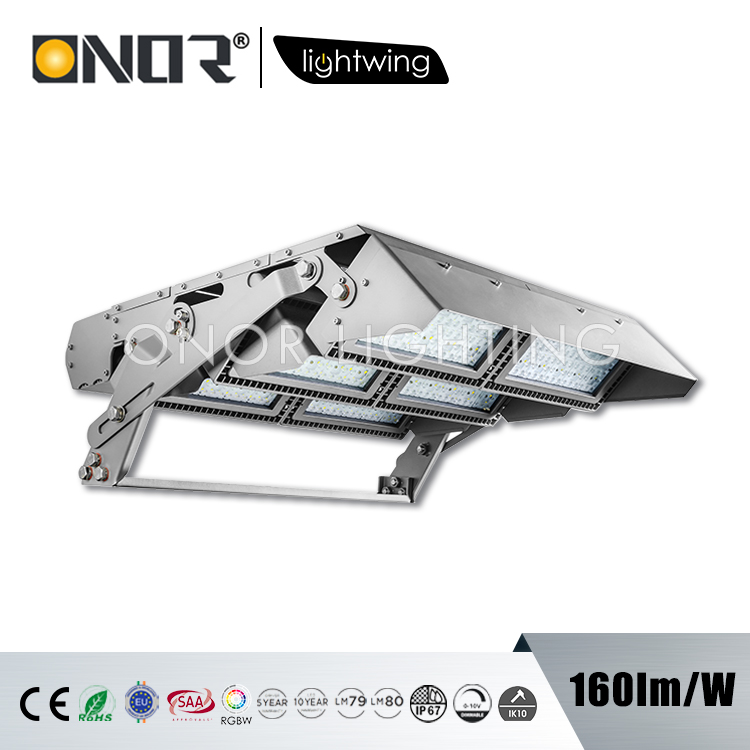
Indoor football stadium ONOR lighting is recommended to use indoor stadium LED flood light (side wall installation) or LED high bay light (applicable when installed on the top).
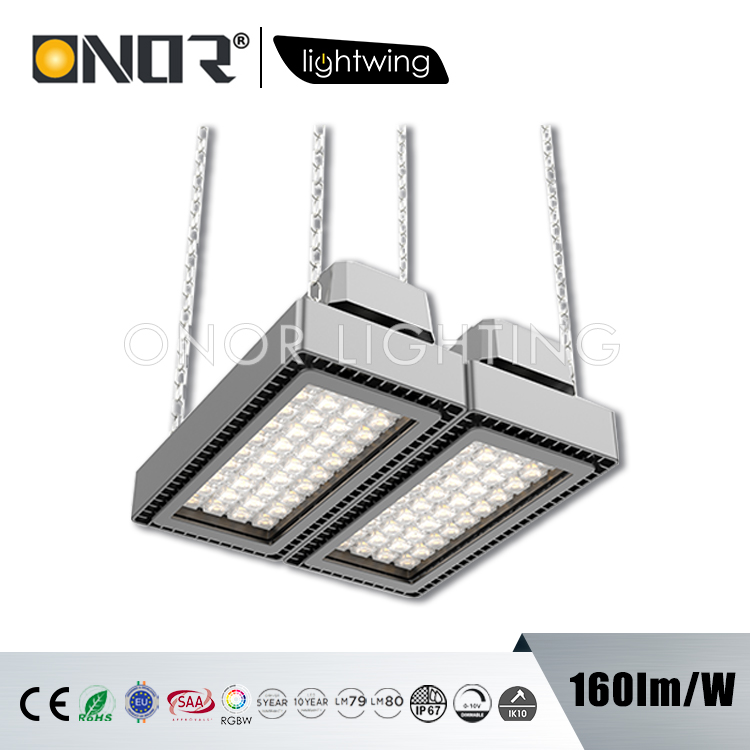
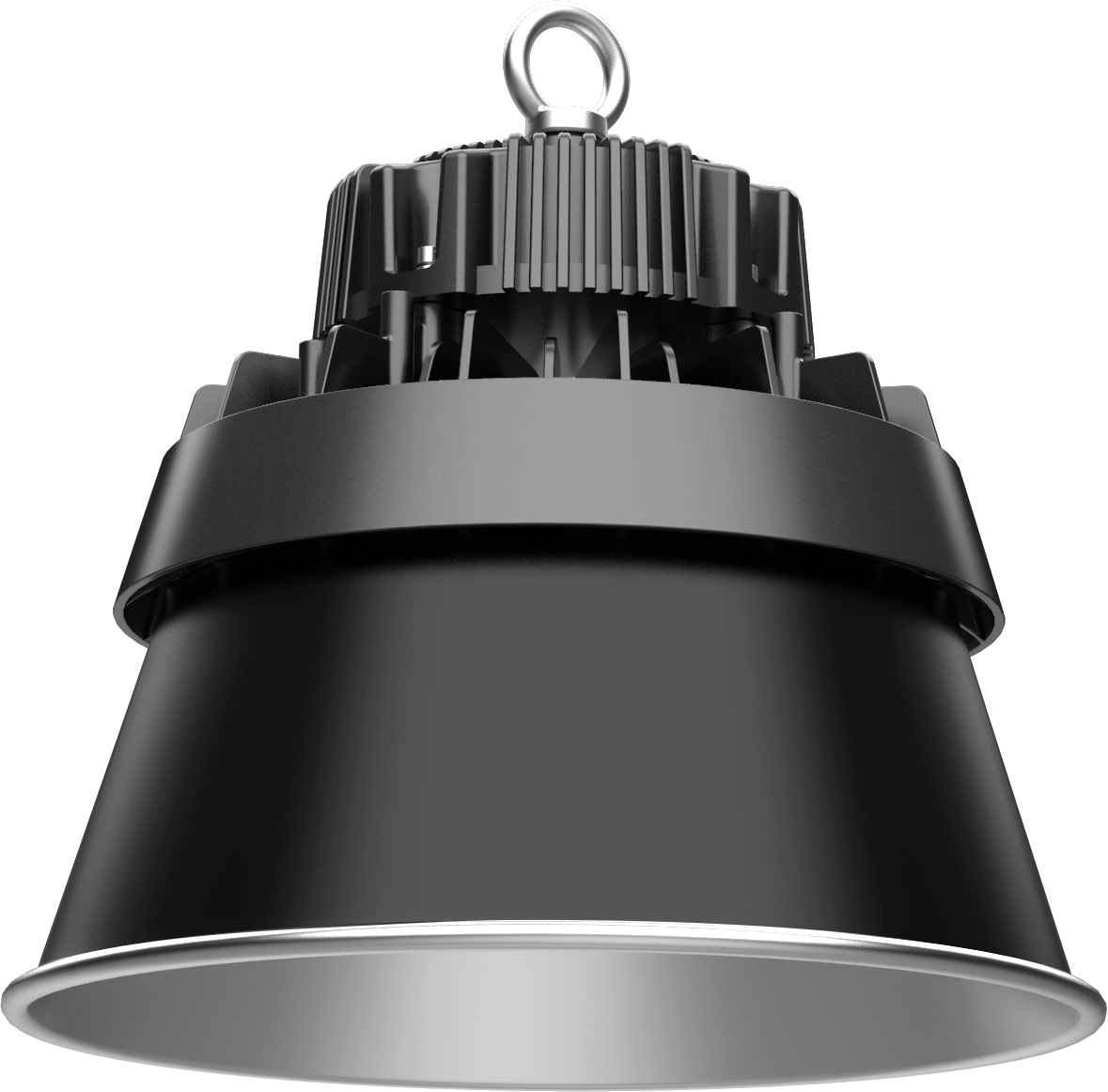
 English
English Español
Español Português
Português Pусский
Pусский Français
Français Deutsch
Deutsch 日本語
日本語 한국어
한국어 Italiano
Italiano عربى
عربى ONOR Lighting
ONOR Lighting